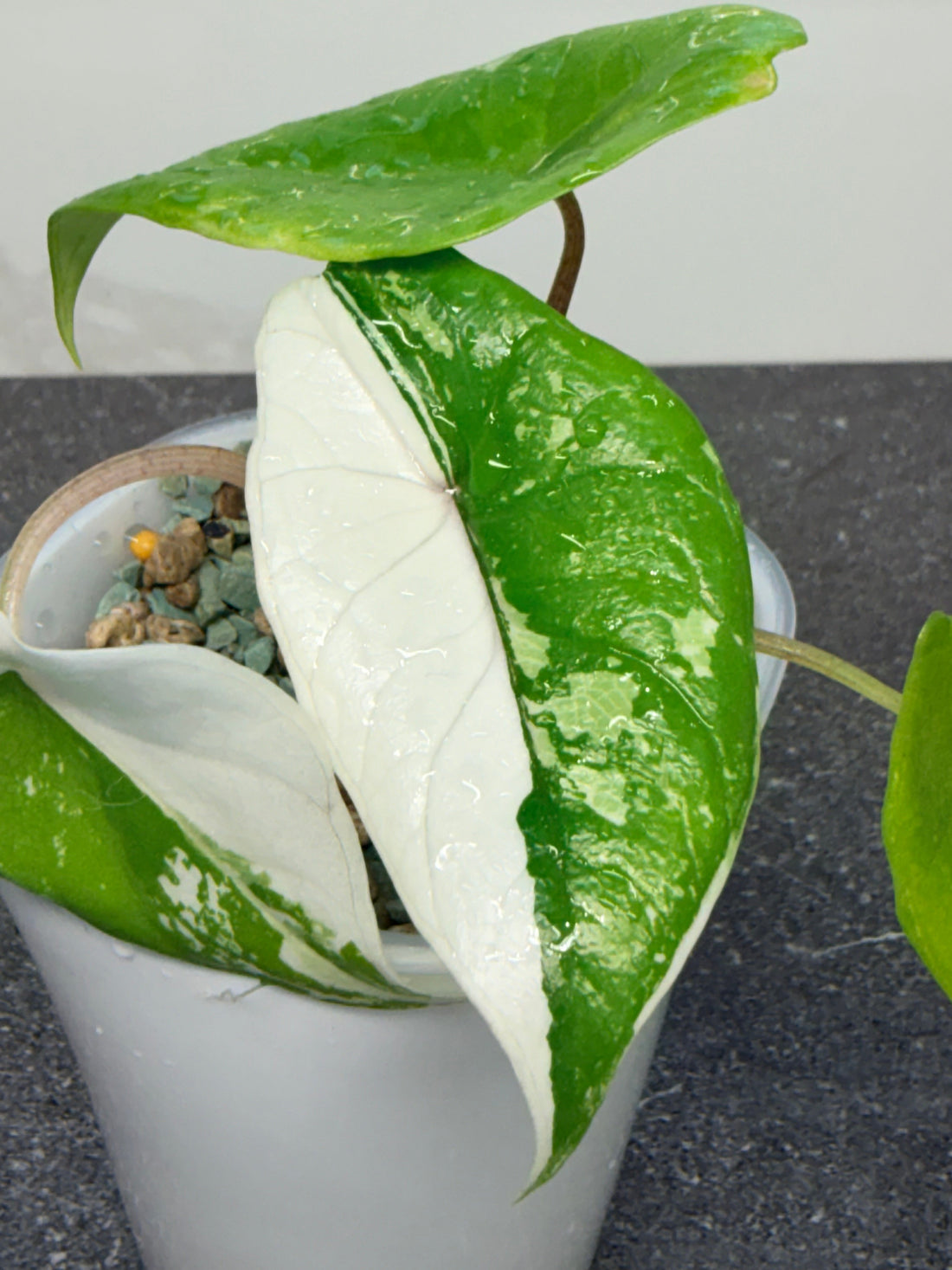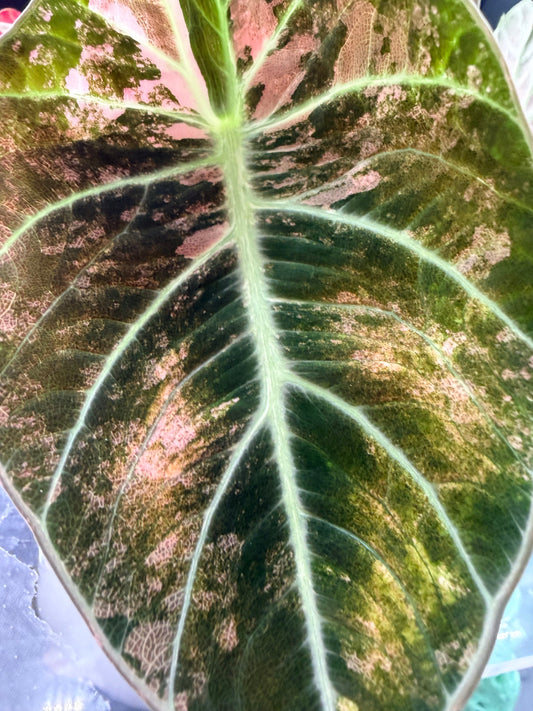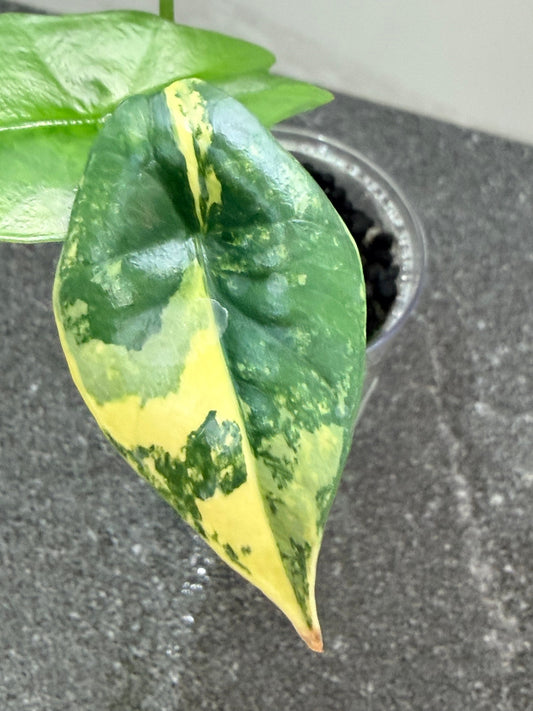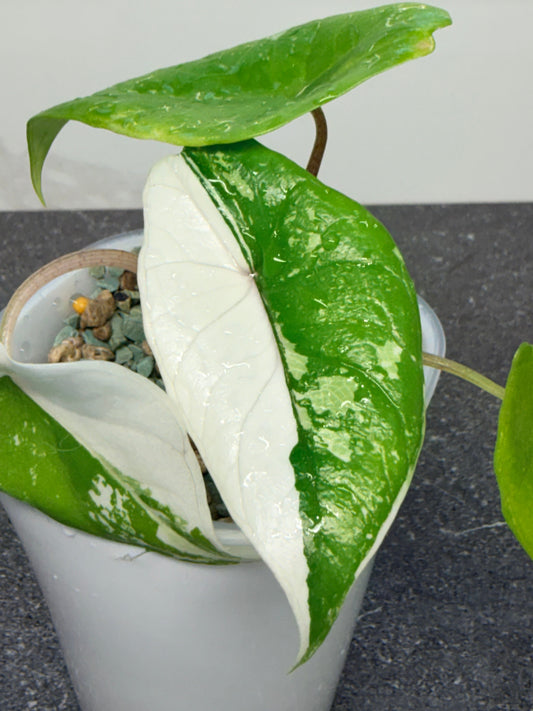
Understanding Albo Variegation in Albo in Alocasia
Share
Understanding Albo Variegation in Alocasia: The Science Behind the White Beauty
Albo variegation in Alocasia plants represents one of the most sought-after characteristics in the plant collecting world. These stunning white and green patterns transform ordinary elephant ear plants into living works of art. In this blog post, we'll explore what albo variegation is, the science behind it, and why these plants command such attention from collectors worldwide.
What Is Albo Variegation?
Albo variegation refers to the white or cream and white colorued patterns that appear on plant leaves. The term "albo" comes from the Latin word for white, perfectly describing the pale, chlorophyll-deficient sections that contrast beautifully against deep green foliage. In Alocasia plants, this variegation can appear as random splashes, sectoral blocks, or marbled patterns—each leaf becoming a unique masterpiece.
Think of albo variegation as nature's artwork. While the green portions of the leaf work hard to photosynthesise and feed the plant, the white sections create visual drama that makes collectors' hearts skip a beat. Popular albo-variegated Alocasias include varieties like Alocasia macrorrhiza 'Albo Variegata', Alocasia longiloba albo, and Alocasia Sarian albo.
The Science Behind Albo Variegation
Understanding Chimeric Variegation
At its core, albo variegation is a genetic phenomenon known as chimeric variegation. Here's where things get fascinating: imagine your Alocasia as having two different genetic identities living within the same plant. Some cells can produce chlorophyll (the green pigment needed for photosynthesis), while others simply cannot.
This genetic mutation occurs in the plant's meristem—the growing tip where new cells are formed. When these cells divide and grow, they create tissue with two distinct genetic makeups. The result? Those spectacular white sections we all admire are areas where the cells completely lack chlorophyll and other leaf pigments.
In Scientific Terms
Chimeric variegation is a somatic mutation that affects the plant's ability to produce chloroplasts in certain cell layers. The white or silver sections of albo-variegated leaves represent a complete absence of chlorophyll, carotenoids, and other photosynthetic pigments. This differs from other types of variegation where some pigment remains.
The pattern you see depends on which cell layers are affected and how they're distributed as the leaf develops. This is why variegated Alocasias can produce leaves with dramatically different patterns—sometimes heavily variegated, sometimes mostly green, and occasionally entirely white (though these cannot survive long-term).
In Simple Terms
Think of your Alocasia as a painter with only two colours: green and white. Some cells got the memo to be green and make food for the plant, while others decided to be fashionably white instead. The white parts are like windows in your leaf—they're missing the green factory (chloroplasts) that normally turns sunlight into plant food.
Because this is random at the cellular level, each new leaf is a surprise. Will it be half white, half green? Mostly green with white splashes? The plant itself doesn't know until the leaf unfurls!
Why Albo Variegation Is Unstable
One of the most important things to understand about albo variegation is its instability. Unlike patterns that are bred true from seed, chimeric variegation can be unpredictable. Your highly variegated Alocasia might suddenly produce an all-green leaf, and that's completely normal.
This happens because:
- The plant needs green tissue to photosynthesise and create energy
- Environmental stress can cause the plant to prioritise survival over aesthetics
- Insufficient light may trigger the plant to produce more chlorophyll-rich leaves
- The random nature of cell division means variegation patterns vary
This instability is also why variegated Alocasia cannot be grown reliably from seed—the variegation must be propagated vegetatively through corms or division to maintain the trait.
Factors Affecting Albo Variegation Display
Light Requirements
Bright, indirect light is crucial for maintaining albo variegation. While it might seem counterintuitive, the white sections need adequate light exposure, even though they can't photosynthesise. Too little light causes the plant to compensate by producing more green leaves. Too much direct sun, however, will scorch those delicate white areas, turning them brown and crispy. Consider using LED Grow Lights available in our store to maintain optimal conditions.
The Balance Challenge
Here's the tricky part: white sections don't produce energy, so a heavily variegated plant grows slower than its all-green cousins. The plant must balance having enough green tissue for survival while maintaining that coveted white variegation. This is why extremely variegated plants are more expensive and challenging to cultivate—they're living on the edge!
Caring for Albo Variegated Alocasias
Special Considerations
Because albo-variegated Alocasia lack chlorophyll in their white sections, they require more attentive care than standard varieties:
- Water carefully: Keep media consistently moist but never waterlogged. White sections are more prone to damage from both under watering and overwatering
- Humidity matters: Aim for 60-80% humidity. The white areas are more delicate and prone to browning in dry conditions
- Fertilise wisely: Use half-strength fertiliser. Variegated plants grow slower and need less feeding
- Temperature stability: Maintain temperatures between 18-27°C (65-80°F). Avoid cold drafts and sudden changes
-
Soil requirements:
Use a well-draining aroid mix:
We recommend Lechuza Pon in a self watering pot
Repot only when necessary, as pink-variegated plants can be sensitive to transplant stress.
Managing Reversion
If your albo-variegated Alocasia starts producing all-green leaves (called reversion), don't panic. Increase light levels gradually and consider cutting back reverted growth to encourage variegated shoots. The variegated portions of the plant are usually found in specific areas of the rhizome, so propagating from highly variegated sections can help maintain the trait.
Propagating Albo Variegated Alocasia
The only way to maintain albo variegation is through vegetative propagation—never from seed. When your plant produces corms, these baby bulbs carry the same genetic makeup as the mother plant. If you want to start a corm journey, try our Corm Starter Kit with three mystery corms!
Key Points for Propagation:
- Divide during the growing season when the plant is actively producing new growth
- Ensure each division has at least one growth point
- The most heavily variegated sections often produce the most variegated offspring
- Be patient—variegated plants grow slower and may take longer to establish
The Value and Rarity of Albo Variegation
Albo-variegated Alocasia command premium prices in the plant market, and for good reason. The unstable nature of the variegation means:
- These plants cannot be mass-produced from seed
- Each plant must be carefully propagated through division
- Growing them requires more time, expertise, and resources
- Heavy variegation is rare and unpredictable
The combination of striking appearance, genetic instability, and slower growth makes albo-variegated Alocasia true collector's items.
Final Thoughts
Albo variegation in Alocasia represents one of nature's most beautiful genetic quirks. The complete absence of chlorophyll in certain cells creates those stunning white patterns we all cherish. Understanding the science behind chimeric variegation helps us appreciate why these plants are so special—and why they require such careful attention.
Whether you're drawn to the dramatic half-moon patterns or subtle white splashes, albo-variegated Alocasia offer something truly unique for your collection. The unpredictable nature of each new leaf keeps things exciting, while the plant's specific care requirements make success all the more rewarding.
For more insights into Alocasia variegation, explore our other articles on Pink Variegation in Alocasia, [Aurea Variegation in Alocasia], and [Complete Guide to Alocasia Variegation Types]. If you're ready to begin growing these stunning plants, check out our [Corm Propagation Guide] to start your journey with confidence.
With proper care and understanding of the science behind albo variegation, you'll be well-equipped to grow these magnificent plants and enjoy their ever-changing beauty.




